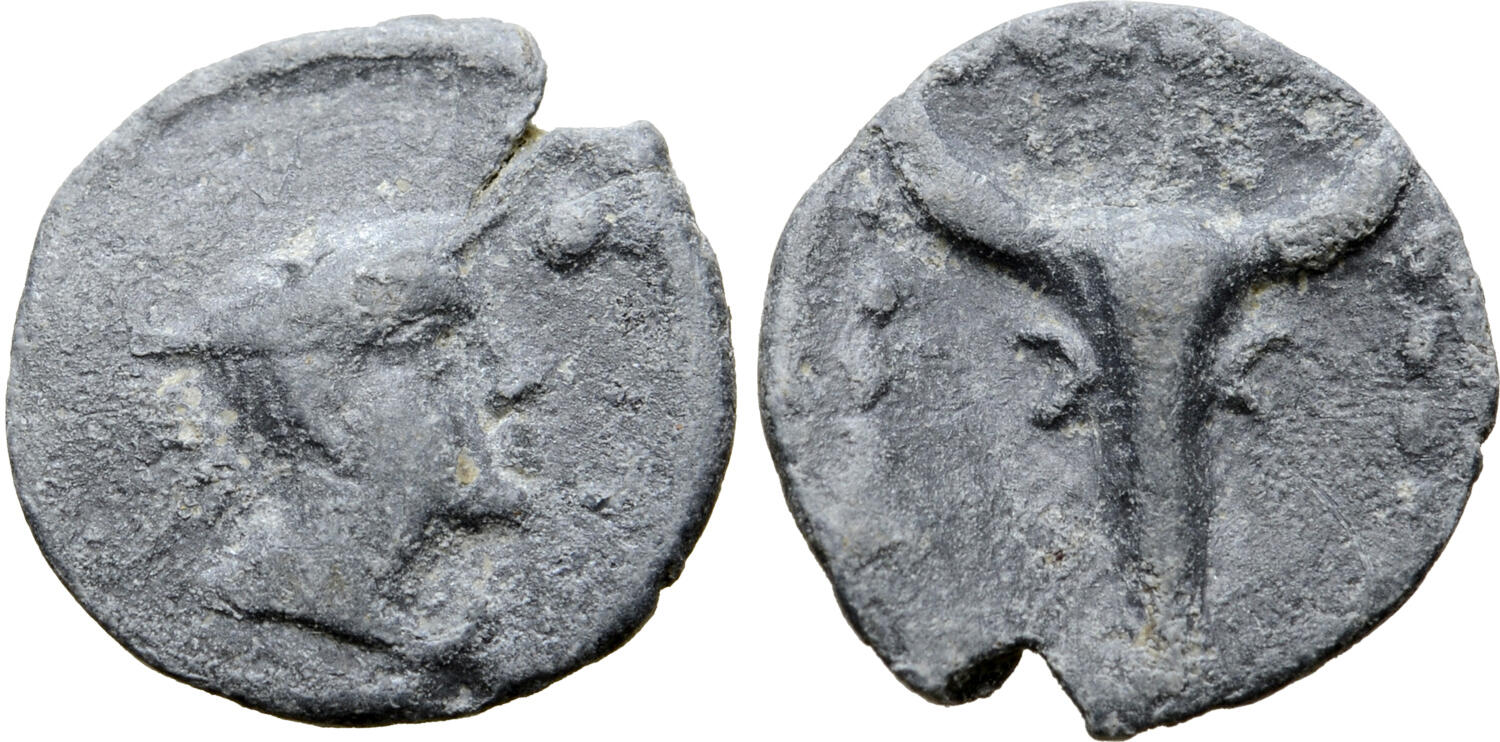S 1723 - Chersonesus, lead (Hermes/bucranium) (200 BCE)
From SILVER
200 BCE - 200 BCE Lead 4,234 kg
Description
| ObverseInscription or printing placed on the obverse.: | Head of Hermes to right, wearing petasos |
| ReverseInscription or printing placed on the reverse.: | Bukranion decorated with garlands |
Mint and issuing power
| MintIdentifies the place of manufacture or issue of a numismatic object.: | Chersonesos | Ancient regionAncient region.: | Bosporus | Modern countryModern country: Russia (Crimea) | AuthorityIdentifies the issuing power. The authority can be "pretended" when the name or the portrait of X is on the coin but he/she was not the issuing power. It can also be "uncertain" when there is no mention of X on the coin but he/she was the issuing power according to the historical sources: |
Chronology
| FromIdentifies the initial date in a range assigned in a numismatic context. | 200 BCE | toIdentifies the final date in a range assigned in a numismatic context.. | 200 BCE | PeriodTime period of the numismatic object.: Hellenistic 323-30 BC |
Physical description
| MetalThe physical material (usually metal) from which an object is made.: | Lead http://nomisma.org/id/pb | Median weightMedian of the weights of numismatic objects (in grams). in grams | 3.00 | DenominationTerm indicating the value of a numismatic object. Examples: tetradrachm, chalkous, denarius.: | tessera | StandardStandard.: |
Image

S1723 Chersonesus lead.jpg [1]
References
| Die study referencePublication of the study: | Kovalenko 20021Kovalenko 2002 | ||
| Coin series referenceReference to coin series study: | |||
Obverse dies distribution
| FrequencyFrequency of specimen in distribution. ᵖ | Number of obversesNumber of obverse dies. ᵖ (o) | % (o) | Number of coinsNumber of coins. (n) | % (n) | Die nameName(s) of the die(s). |
| 1 | 29 | 63.04 | 29 | 29.29 | 1/2, 1/3, 1/8, 1/9, 1/10, 1/11, 1/12, 2/4, 2/5, 2/7, 3/1, 3/2, 4/3, 4/7, 4/8, 4/9, 4/10, 6/1, 6/2, 6/3, 6/4, 6/5, 6/6, 8/1, 9/1, 10/1, 11/1, 12/1, 12/3 |
| 2 | 6 | 13.04 | 12 | 12.12 | 1/6, 1/7, 2/8, 4/6, 7/1, 12/2 |
| 3 | 5 | 10.87 | 15 | 15.15 | 1/4, 1/5, 2/2, 2/3, 4/2 |
| 5 | 3 | 6.52 | 15 | 15.15 | 1/1, 2/1, 2/6 |
| 8 | 2 | 4.35 | 16 | 16.16 | 4/1, 4/4 |
| 12 | 1 | 2.17 | 12 | 12.12 | 4/5 |
| Total | 46 of 46 | 99.99 | 99 of 99 | 99.99 |
Reverse dies distribution
no distribution is available
Quantification
| Number of obversesNumber of obverse dies. ᵖ (o) | 46 | Number of singletons (o1)The number of singleton coins. ᵖ | 29 |
| Number of reverse diesNumber of reverse dies. (r) | Number of coinsNumber of coins. (n) | 99 | |
| Coins per obverse dieNumber of coins per obverse die. (n/o) | 2.15 | Coins per reverse dieNumber of coins per reverse die. (n/r) | |
| Reverse per obverse ratioRatio of obverse dies divided by reverse dies. (r/o) | Percentage of singletons (o1)number of coins (n) divided by the number of singletons (o1) ᵖ | 63.04 % | |
| Original number of dies (O) (Carter 1983 formula)The estimation of the number of coins according to Carter 1983 ᵖ | 70.56 | Coins struck if 20,000 as average productivity per dieCoins made if the average productivity for obverses (according to Carter) is 20,000. ᵖ | 1,411,200 |
| Original number of dies (O) (Esty 2011 formula)The estimation of the number of coins according to the singleton formula in Esty 2011 ᵖ (O) | 85.92 | Survival rate if 20,000 as average productivity per dieSurvival rate if average productivity is 20,000. ᵖ | 0.00007 |
| Coverage (o = % of O) (Esty 1984 formula)Esty 1984 - coverage (% of O) ᵖ (o = % of O) | 70.71% | Die productivity if survival rate 1/2,000Average productivity if survival rate is 1/2,000. ᵖ | 2,806.12 |
| Weight of silver (in kg) if 20,000 coins per die (O = Carter formula)Carter 1983 * Median weight * 20000 (*10 if gold or electrum) ᵖ | 4,234 kg <br /> 4,234 kg | Die productivity if survival rate 1/5,000Average productivity if survival rate is 1/5,000. ᵖ | 7,015.31 |
Remarks